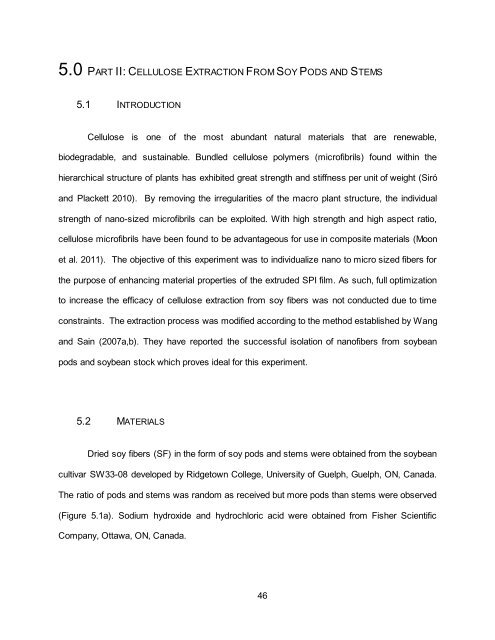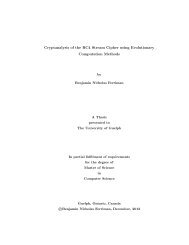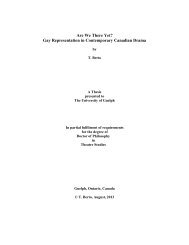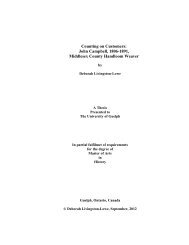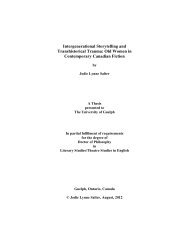THESIS - ROC CH ... - FINAL - resubmission.pdf - University of Guelph
THESIS - ROC CH ... - FINAL - resubmission.pdf - University of Guelph
THESIS - ROC CH ... - FINAL - resubmission.pdf - University of Guelph
Create successful ePaper yourself
Turn your PDF publications into a flip-book with our unique Google optimized e-Paper software.
5.0 PART II: CELLULOSE EXTRACTION FROM SOY PODS AND STEMS<br />
5.1 INTRODUCTION<br />
Cellulose is one <strong>of</strong> the most abundant natural materials that are renewable,<br />
biodegradable, and sustainable. Bundled cellulose polymers (micr<strong>of</strong>ibrils) found within the<br />
hierarchical structure <strong>of</strong> plants has exhibited great strength and stiffness per unit <strong>of</strong> weight (Siró<br />
and Plackett 2010). By removing the irregularities <strong>of</strong> the macro plant structure, the individual<br />
strength <strong>of</strong> nano-sized micr<strong>of</strong>ibrils can be exploited. With high strength and high aspect ratio,<br />
cellulose micr<strong>of</strong>ibrils have been found to be advantageous for use in composite materials (Moon<br />
et al. 2011). The objective <strong>of</strong> this experiment was to individualize nano to micro sized fibers for<br />
the purpose <strong>of</strong> enhancing material properties <strong>of</strong> the extruded SPI film. As such, full optimization<br />
to increase the efficacy <strong>of</strong> cellulose extraction from soy fibers was not conducted due to time<br />
constraints. The extraction process was modified according to the method established by Wang<br />
and Sain (2007a,b). They have reported the successful isolation <strong>of</strong> nan<strong>of</strong>ibers from soybean<br />
pods and soybean stock which proves ideal for this experiment.<br />
5.2 MATERIALS<br />
Dried soy fibers (SF) in the form <strong>of</strong> soy pods and stems were obtained from the soybean<br />
cultivar SW33-08 developed by Ridgetown College, <strong>University</strong> <strong>of</strong> <strong>Guelph</strong>, <strong>Guelph</strong>, ON, Canada.<br />
The ratio <strong>of</strong> pods and stems was random as received but more pods than stems were observed<br />
(Figure 5.1a). Sodium hydroxide and hydrochloric acid were obtained from Fisher Scientific<br />
Company, Ottawa, ON, Canada.<br />
46


